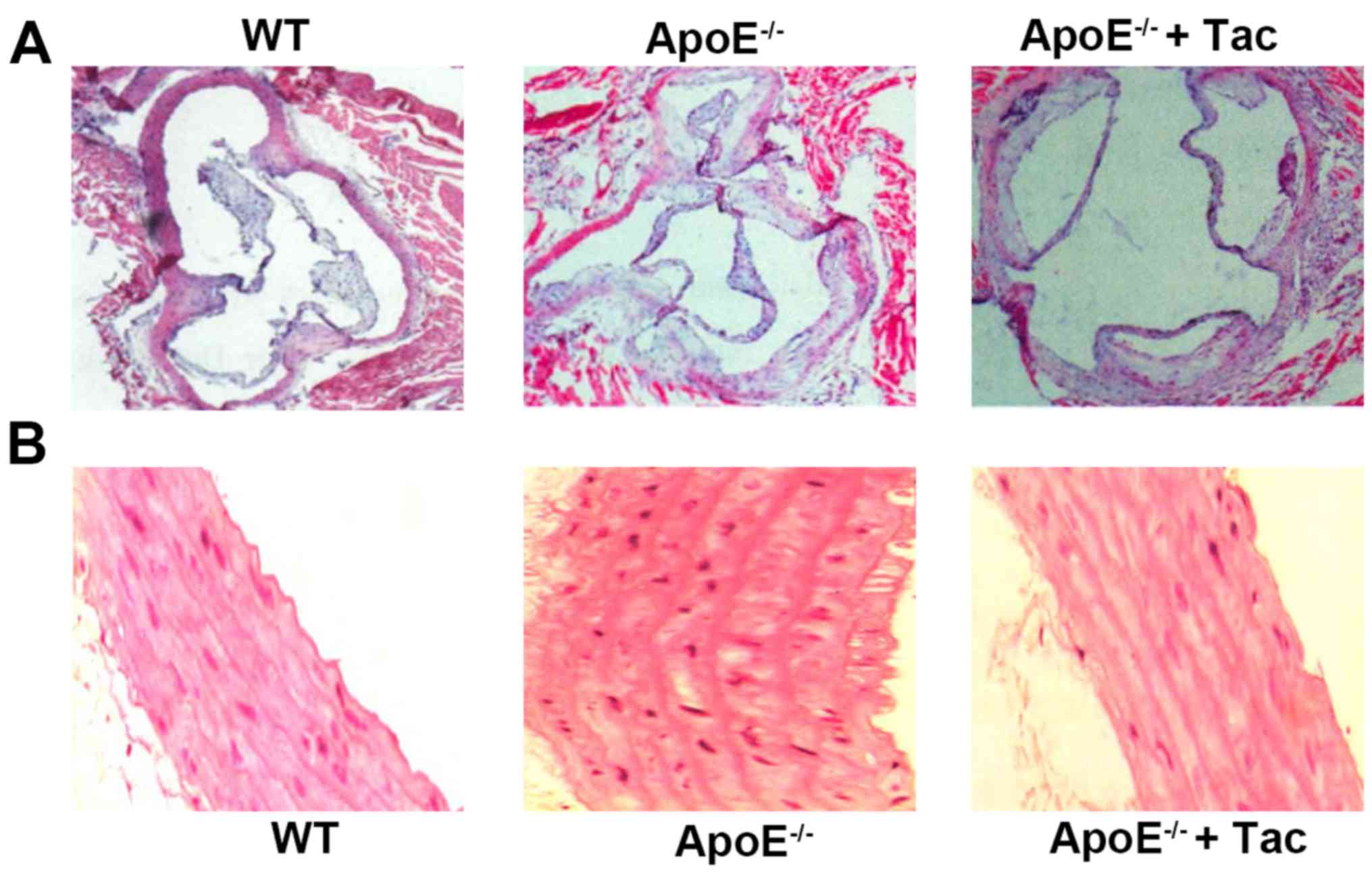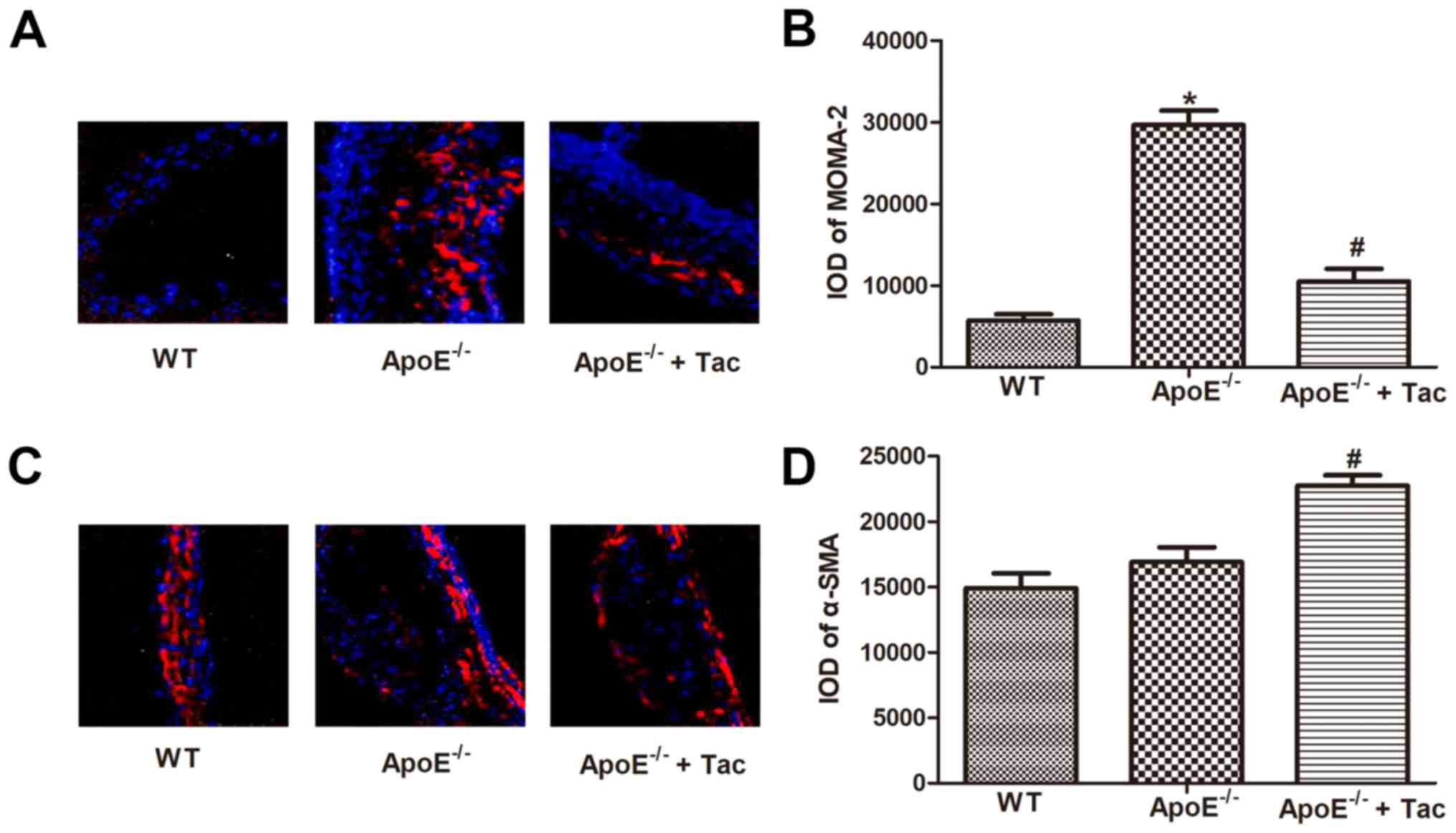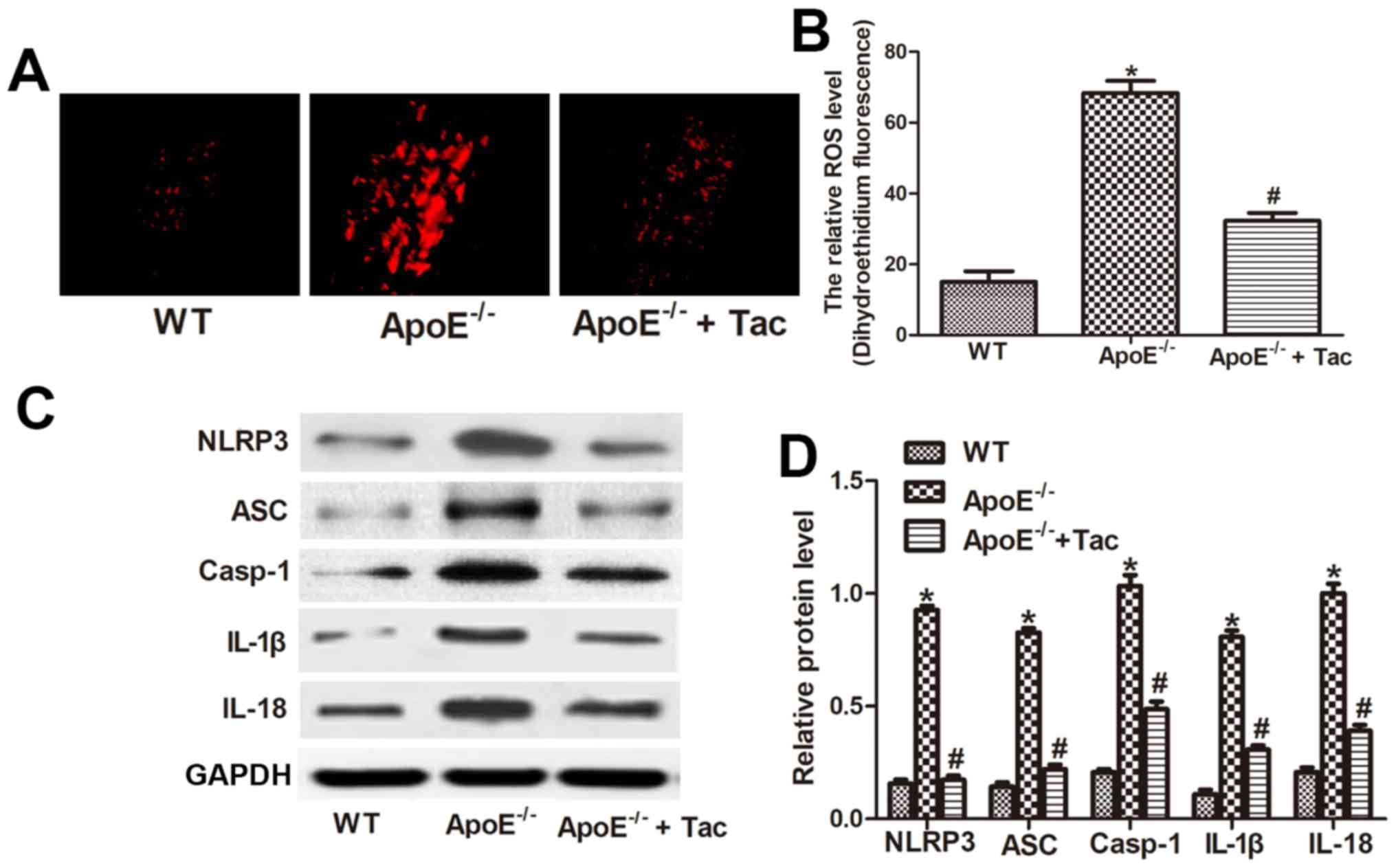|
1
|
Wong MC, Zhang DX and Wang HH: Rapid
emergence of atherosclerosis in Asia: A systematic review of
coronary atherosclerotic heart disease epidemiology and
implications for prevention and control strategies. Curr Opin
Lipidol. 26:257–269. 2015. View Article : Google Scholar : PubMed/NCBI
|
|
2
|
Lyu Y, Jiang X and Dai W: The roles of a
novel inflammatory neopterin in subjects with coronary
atherosclerotic heart disease. Int Immunopharmacol. 24:169–172.
2015. View Article : Google Scholar : PubMed/NCBI
|
|
3
|
Xu F, Chen YG, Geng YJ, Zhang H, Jiang CX,
Sun Y, Li RJ, Sagar MB, Xue L and Zhang Y: The polymorphism in
acetaldehyde dehydrogenase 2 gene, causing a substitution of Glu
> Lys(504), is not associated with coronary atherosclerosis
severity in Han Chinese. Tohoku J Exp Med. 213:215–220. 2007.
View Article : Google Scholar : PubMed/NCBI
|
|
4
|
Li J, Lei HT, Cao L, Mi YN, Li S and Cao
YX: Crocin alleviates coronary atherosclerosis via inhibiting lipid
synthesis and inducing M2 macrophage polarization. Int
Immunopharmacol. 55:120–127. 2018. View Article : Google Scholar : PubMed/NCBI
|
|
5
|
Ravi S, Schuck RN, Hilliard E, Lee CR, Dai
X, Lenhart K, Willis MS, Jensen BC, Stouffer GA, Patterson C, et
al: Clinical evidence supports a protective role for CXCL5 in
coronary artery disease. Am J Pathol. 187:2895–2911. 2017.
View Article : Google Scholar : PubMed/NCBI
|
|
6
|
Keles N, Aksu F, Aciksari G, Yilmaz Y,
Demircioglu K, Kostek O, Cekin ME, Kalcik M and Caliskan M: Is
triglyceride/HDL ratio a reliable screening test for assessment of
atherosclerotic risk in patients with chronic inflammatory disease?
North Clin Istanb. 3:39–45. 2016.PubMed/NCBI
|
|
7
|
Samsonova NG, Zvenigorodskaia LA,
Cherkashova EA and Lazebnik LB: Intestinal dysbiosis and
atherogenic dyslipidemia. Eksp Klin Gastroenterol. 3:88–94.
2010.(In Russian).
|
|
8
|
Zeng Z, Cao B, Guo X, Li W, Li S, Chen J,
Zhou W, Zheng C and Wei Y: Apolipoprotein B-100 peptide 210
antibody inhibits atherosclerosis by regulation of macrophages that
phagocytize oxidized lipid. Am J Transl Res. 10:1817–1828.
2018.PubMed/NCBI
|
|
9
|
Ma J, Liu C, Yang Y, Yu J, Yang J, Yu S,
Zhang J and Huang L: C/EBPβ acts upstream of NF-κB P65 subunit in
Ox-LDL-induced IL-1β production by macrophages. Cell Physiol
Biochem. 48:1605–1615. 2018. View Article : Google Scholar : PubMed/NCBI
|
|
10
|
Formanowicz D, Gutowska K and Formanowicz
P: Theoretical studies on the engagement of interleukin 18 in the
immuno-inflammatory processes underlying atherosclerosis. Int J Mol
Sci. 19:192018. View Article : Google Scholar
|
|
11
|
Cheng Y, Li S, Wang M, Cheng C and Liu R:
Peroxisome proliferator activated receptor gamma (PPARγ) agonist
rosiglitazone ameliorate airway inflammation by inhibiting
Toll-like receptor 2 (TLR2)/Nod-like receptor with pyrin domain
containing 3 (NLRP3) inflammatory corpuscle activation in asthmatic
mice. Med Sci Monit. 24:9045–9053. 2018. View Article : Google Scholar : PubMed/NCBI
|
|
12
|
Liu FQ, Gao Q, Wang DD and Zhang ZX:
Effects of GBE50 on LPS/ATP induced NLRP3 inflammasome activation
in primary rat microglia. Zhongguo Zhong Yao Za Zhi. 43:3346–3352.
2018.(In Chinese). PubMed/NCBI
|
|
13
|
Ratajczak MZ, Adamiak M, Thapa A, Bujko K,
Brzezniakiewicz-Janus K and Lenkiewicz AM: NLRP3 inflammasome
couples purinergic signaling with activation of the complement
cascade for the optimal release of cells from bone marrow.
Leukemia. 33:815–825. 2019. View Article : Google Scholar : PubMed/NCBI
|
|
14
|
Baljon JJ, Dandy A, Wang-Bishop L, Wehbe
M, Jacobson ME and Wilson JT: The efficiency of cytosolic drug
delivery using pH-responsive endosomolytic polymers does not
correlate with activation of the NLRP3 inflammasome. Biomater Sci.
7:1888–1897. 2019. View Article : Google Scholar : PubMed/NCBI
|
|
15
|
Wang L, Xi J, Zhang S, Wu H, Zhou L, Lu J,
Zhang T and Zhao C: Effectiveness and safety of tacrolimus therapy
for myasthenia gravis: A single arm meta-analysis. J Clin Neurosci.
63:160–167. 2019. View Article : Google Scholar : PubMed/NCBI
|
|
16
|
Darlenski R: Probable contact urticaria
caused by tacrolimus-containing ointment in the treatment of atopic
dermatitis. J Allergy Clin Immunol Pract. 7:1665–1667. 2019.
View Article : Google Scholar : PubMed/NCBI
|
|
17
|
Tani C, Elefante E, Martin-Cascón M,
Belhocine M, Lavilla Olleros C, Vagelli R, Stagnaro C,
Costedoat-Chalumeau N, Ruiz-Irastorza G and Mosca M: Tacrolimus in
non-Asian patients with SLE: A real-life experience from three
European centres. Lupus Sci Med. 5:e0002742018. View Article : Google Scholar : PubMed/NCBI
|
|
18
|
De Majumdar S, Subinya M, Korward J,
Pettigrew A, Scherer D and Xu H: A Low concentration of
tacrolimus/semifluorinated alkane (SFA) eyedrop suppresses
intraocular inflammation in experimental models of uveitis. Curr
Mol Med. 17:211–220. 2017. View Article : Google Scholar : PubMed/NCBI
|
|
19
|
Pratschke S, Arnold H, Zollner A, Heise M,
Pascher A, Schemmer P, Scherer MN, Bauer A, Jauch KW, Werner J, et
al: Results of the TOP Study: Prospectively randomized multicenter
trial of an ex vivo tacrolimus rinse before transplantation in EDC
livers. Transplant Direct. 2:e762016. View Article : Google Scholar : PubMed/NCBI
|
|
20
|
Kannegieter NM, Hesselink DA, Dieterich M,
de Graav GN, Kraaijeveld R, Rowshani AT, Leenen PJM and Baan CC:
Pharmacodynamic monitoring of tacrolimus-based immunosuppression in
CD14+ monocytes after kidney transplantation. Ther Drug
Monit. 39:463–471. 2017. View Article : Google Scholar : PubMed/NCBI
|
|
21
|
Kaabak M, Babenko N, Shapiro R, Zokoyev A,
Dymova O and Kim E: A prospective randomized, controlled trial of
eculizumab to prevent ischemia-reperfusion injury in pediatric
kidney transplantation. Pediatr Transplant. 22:222018. View Article : Google Scholar
|
|
22
|
Lei WT, Lin HH, Tsai MC, Hung HH, Cheng
YJ, Liu SJ, Lin CY and Yeh TL: The effects of macrolides in
children with reactive airway disease: A systematic review and
meta-analysis of randomized controlled trials. Drug Des Devel Ther.
12:3825–3845. 2018. View Article : Google Scholar : PubMed/NCBI
|
|
23
|
Rizvi S, Tariq S, Mehdi M and Hassan AJ:
Synthesis of 99mTc-roxithromycin: A novel diagnostic
agent to discriminate between septic and aseptic inflammation. Chem
Biol Drug Des. 93:1166–1174. 2019. View Article : Google Scholar : PubMed/NCBI
|
|
24
|
Ersoy B, Aktan B, Kilic K, Sakat MS and
Sipal S: The anti-inflammatory effects of erythromycin,
clarithromycin, azithromycin and roxithromycin on histamine-induced
otitis media with effusion in guinea pigs. J Laryngol Otol.
132:579–583. 2018. View Article : Google Scholar : PubMed/NCBI
|
|
25
|
Zhang L, Issa Bhaloo S, Chen T, Zhou B and
Xu Q: Role of resident stem cells in vessel formation and
arteriosclerosis. Circ Res. 122:1608–1624. 2018. View Article : Google Scholar : PubMed/NCBI
|
|
26
|
Vigil SV, de Liz R, Medeiros YS and Fröde
TS: Efficacy of tacrolimus in inhibiting inflammation caused by
carrageenan in a murine model of air pouch. Transpl Immunol.
19:25–29. 2008. View Article : Google Scholar : PubMed/NCBI
|
|
27
|
Howard AN and Thurnham DI: Lutein and
atherosclerosis: Belfast versus Toulouse revisited. Med Hypotheses.
98:63–68. 2017. View Article : Google Scholar : PubMed/NCBI
|
|
28
|
Ohara K, Wakabayashi H, Taniguchi Y,
Shindo K, Yajima H and Yoshida A: Quercetin-3-O-glucuronide induces
ABCA1 expression by LXRα activation in murine macrophages. Biochem
Biophys Res Commun. 441:929–934. 2013. View Article : Google Scholar : PubMed/NCBI
|
|
29
|
Wang D, Wang W, Lin W, Yang W, Zhang P,
Chen M, Ding D, Liu C, Zheng J and Ling W: Apoptotic cell induction
of miR-10b in macrophages contributes to advanced atherosclerosis
progression in ApoE−/− mice. Cardiovasc Res.
114:1794–1805. 2018. View Article : Google Scholar : PubMed/NCBI
|
|
30
|
Watanabe R, Watanabe H, Takahashi Y,
Kojima M, Konii H, Watanabe K, Shirai R, Sato K, Matsuyama TA,
Ishibashi-Ueda H, et al: Atheroprotective effects of tumor necrosis
factor-stimulated Gene-6. JACC Basic Transl Sci. 1:494–509. 2016.
View Article : Google Scholar : PubMed/NCBI
|
|
31
|
Shindyapina AV, Mkrtchyan GV, Gneteeva T,
Buiucli S, Tancowny B, Kulka M, Aliper A and Zhavoronkov A:
Mineralization of the connective tissue: A complex molecular
process leading to age-related loss of function. Rejuvenation Res.
17:116–133. 2014. View Article : Google Scholar : PubMed/NCBI
|
|
32
|
Li C, Chen JW, Liu ZH, Shen Y, Ding FH, Gu
G, Liu J, Qiu JP, Gao J, Zhang RY, et al: CTRP5 promotes
transcytosis and oxidative modification of low-density lipoprotein
and the development of atherosclerosis. Atherosclerosis.
278:197–209. 2018. View Article : Google Scholar : PubMed/NCBI
|
|
33
|
Wang Q, Zhang J, Li Y, Shi H, Wang H, Chen
B, Wang F, Wang Z, Yang Z and Wang L: Green tea polyphenol
epigallocatechin-3-gallate increases atherosclerotic plaque
stability in apolipoprotein E-deficient mice fed a high-fat diet.
Kardiol Pol. 76:1263–1270. 2018. View Article : Google Scholar : PubMed/NCBI
|
|
34
|
Silverman M: Structure and function of
hexose transporters. Annu Rev Biochem. 60:757–794. 1991. View Article : Google Scholar : PubMed/NCBI
|
|
35
|
Hornung V, Bauernfeind F, Halle A, Samstad
EO, Kono H, Rock KL, Fitzgerald KA and Latz E: Silica crystals and
aluminum salts activate the NALP3 inflammasome through phagosomal
destabilization. Nat Immunol. 9:847–856. 2008. View Article : Google Scholar : PubMed/NCBI
|
|
36
|
Pelegrin P, Barroso-Gutierrez C and
Surprenant A: P2X7 receptor differentially couples to distinct
release pathways for IL-1beta in mouse macrophage. J Immunol.
180:7147–7157. 2008. View Article : Google Scholar : PubMed/NCBI
|
|
37
|
Sodhi K, Srikanthan K, Goguet-Rubio P,
Nichols A, Mallick A, Nawab A, Martin R, Shah PT, Chaudhry M,
Sigdel S, et al: pNaKtide attenuates steatohepatitis and
atherosclerosis by blocking Na/K-ATPase/ROS amplification in C57Bl6
and ApoE knockout mice fed a western diet. Sci Rep. 7:1932017.
View Article : Google Scholar : PubMed/NCBI
|
|
38
|
Rajkumari J, Dyavaiah M, Sudharshan SJ and
Busi S: Evaluation of in vivo antioxidant potential of Syzygium
jambos (L.) Alston and Terminalia citrina Roxb. towards
oxidative stress response in Saccharomyces cerevisiae. J Food Sci
Technol. 55:4432–4439. 2018. View Article : Google Scholar : PubMed/NCBI
|
|
39
|
Zhu J, Xu C, Ning R, Chai D and Lin J:
Effects and related mechanism of retinoid X receptor agonist
bexarotene on atherosclerosis progression in diabetic apoE(−/-)
mice. Zhonghua Xin Xue Guan Bing Za Zhi. 42:492–497. 2014.(In
Chinese). PubMed/NCBI
|
|
40
|
Huang H, Koelle P, Fendler M, Schröttle A,
Czihal M, Hoffmann U, Conrad M and Kuhlencordt PJ: Induction of
inducible nitric oxide synthase (iNOS) expression by oxLDL inhibits
macrophage derived foam cell migration. Atherosclerosis.
235:213–222. 2014. View Article : Google Scholar : PubMed/NCBI
|














